#Pm shri schools
Explore tagged Tumblr posts
Text
0 notes
Text
Benefits of Experiential Learning for Teaching STEM to Children
Introduction
Teaching STEM to children is essential for fostering a love for learning and curiosity about the world. Experiential STEM learning, a method where students learn through hands-on experiences, is increasingly being integrated into STEM (Science, Technology, Engineering, and Mathematics) education. This approach makes learning more engaging and equips students with the skills they need for the future. At Respire Learning, we aim to transform children's education through experiential learning. Our STEM Kits provide hands-on activities that introduce children to science, technology, engineering, and math concepts engagingly and interactively. With Robotics Kits, students can dive into programming and automation, learning to build and control their robots. Our DIY Models foster creativity and problem-solving by allowing students to assemble projects independently. These Experiential Learning Kits are designed to ignite curiosity, promote critical thinking, and inspire the next generation of innovators.

What is Experiential Learning?
Experiential learning involves learning through direct experience and reflection. Unlike traditional methods that rely heavily on lectures and rote memorization, experiential learning emphasizes active participation and practical application. This method allows students to explore, experiment, and learn from their successes and mistakes.
Respire’s agenda to focus on STEM Education
STEM education focuses on teaching students in an integrated manner, combining science, technology, engineering, and mathematics. It's designed to prepare students for the complexities of the modern world. Experiential learning fits seamlessly into STEM education, as both prioritize critical thinking, problem-solving, and real-world application.

Advantages of Experiential Learning
Enhances Understanding and Retention Experiential learning helps students understand and remember concepts better by involving them in activities that require active engagement. Students participating in experiments or projects are more likely to retain the information.
Encourages Critical Thinking and Problem-Solving Hands-on activities require students to think critically and solve problems. This approach fosters a deeper understanding of scientific principles and enhances students' ability to apply knowledge in various situations. Promotes Engagement and Motivation Experiential learning makes STEM fun and interesting. Students are more motivated to learn when they can see the relevance of their studies and actively participate in the learning process. Develops Practical Skills Through experiential learning, students develop practical skills essential in the real world. These skills include teamwork, communication, and technical abilities crucial for future success. Respire’s Experiential Learning Kits Experiential learning kits are tools designed to provide hands-on learning experiences. These kits include materials and instructions for conducting experiments and activities. They are tailored to different age groups and educational levels, making STEM accessible and enjoyable for all students. Examples of Popular Kits for Teaching STEM
STEM Kits: These kits cover various subjects like electronics, engineering, chemistry, and physics, providing comprehensive learning experiences.
DIY Kits: These kits allow students to conduct experiments at home, fostering a love for learning outside the classroom.
Robotics Kits: These robotics kits teach students about advanced-level engineering and technology through building and programming robots.

Implementing STEM Labs in the Classroom
Teachers can integrate experiential learning into their classrooms using kits and hands-on activities. Here are some strategies:
Strategies for Teachers
Incorporate Experiments: Regularly include experiments and practical activities in lesson plans.
Use Learning Kits: Utilize available experiential learning kits to make science lessons more interactive.
Encourage Group Work: Promote teamwork by having students work in groups on projects and experiments.
Integrating Kits and Hands-On Activities
Integrating kits into the curriculum can be seamless. Teachers can start with simple kits and gradually introduce more complex ones as students become more comfortable with hands-on learning.

Traditional Learning & Learning in STEM Lab
Common Obstacles in Experiential Learning
Limited Resources: Schools may need more resources for experiential learning.
Time Constraints: Hands-on activities can be time-consuming.
Teacher Training: Not all teachers are trained in experiential learning methods.
Benefits of STEM Lab
Experiential STEM Kits: students have a variety of kits in STEM with which they can do hands-on experiments with the teacher's guidance.
Look and Feel of the lab: Our Innovation lab is a specially curated space for children with a Montessori color combination that can promote learning in the gated space.
Children's safe Equipment and kits: All the kits representing various subjects and their theories are perfectly safe for students to use from pre-primary to higher secondary education.
Teacher Training: Teachers are specially trained to use high-functioning equipment easily, they also teach the importance of storytelling which can help students to make boring theories interesting.
Experiential Learning Beyond the Classroom
Learning continues beyond the classroom door. Parents and guardians can support experiential learning at home by providing resources and engaging in educational activities with their children.
Importance of Learning at Home and in the Community
Home Activities: Simple experiments and DIY kits can make learning STEM fun at home.
Community Resources: Local museums, science centers, and libraries often offer hands-on learning opportunities.

Future of Experiential Learning in STEM
The future of experiential learning in STEM education looks promising. With technological advancements and an increasing focus on hands-on learning, we can expect more innovative and effective methods to emerge.
Trends and Innovations
Virtual Reality (VR): VR can provide immersive learning experiences.
Online Platforms: Online resources and platforms can offer interactive science activities.
Predictions for the Future
As experiential learning continues to evolve and Indian government is implementing experiential learning by putting STEM education in the National Education Policy 2020 and evolving as time passes by. it will likely become a staple in education, preparing students for future challenges and making them tech-savvy.
Conclusion
Experiential learning offers numerous benefits for teaching STEM to children. Engaging students in hands-on activities can enhance their understanding, foster critical thinking, and develop practical skills. As we look to the future, it's clear that experiential learning will play a crucial role in STEM education in the Indian Education System.
FAQs
What is the main benefit of experiential learning in STEM education?
The main advantage is that it enhances understanding and retention by involving students in hands-on activities.
How can parents support experiential learning at home?
Parents can support experiential learning by providing DIY STEM kits and engaging in simple experiments with their children.
Are there any specific experiential learning kits for different age groups?
Yes, kits are designed for various age groups, from preschoolers to high school students, ensuring age-appropriate learning experiences.
What are some challenges teachers might face with experiential learning?
Teachers face challenges such as limited resources, time constraints, and the need for specialized training.
How does experiential learning prepare children for future careers?
Experiential learning develops practical skills, critical thinking, and problem-solving abilities, essential for future jobs.
#Robotic kits#Science kit#Robotics labs#ATL tinkering lab#Pm shri schools#Innovation lab#Girls in stem#Science labs#Respire group#Respire learning#Stem lab#stem learning#STEM education in india#STEM Labs in India#stem education services in india#stem lab curriculum#stem lab school classroom#stem learning labs#stem robotics education services in india#ai education in India#benefits of experiential learning#advantages of experiential learning#Experiential Learning Kits#Experiential Kits#use of ai education in india#stem lab in schools#stemlabs#experiential learning advantages#stem labs for high school#experiential learning benefit for students
0 notes
Text

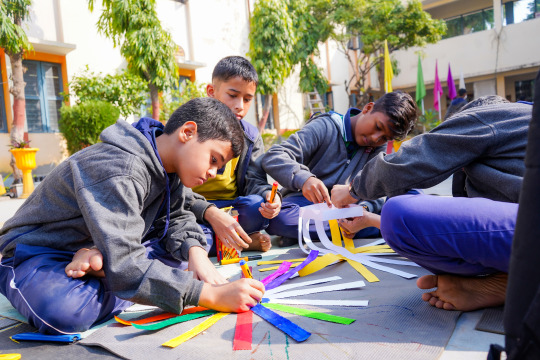




PM Shri Schools hosted a fun-filled workshop by VIRSA INDIA, teaching paper making, sketching, paper craft, and paper lamp crafting!
0 notes
Text
Teachers' Association Elects New Leadership in Jamshedpur
JSSTA’s East Singhbhum unit forms new executive body at district convention Key Points: • East Singhbhum JSSTA holds district convention, restructures executive body • MLA Saryu Rai emphasizes importance of quality education at the event • New committee aims to strengthen teachers’ rights and educational reform JAMSHEDPUR – The local teachers’ association has elected new leadership, signaling a…
#आयोजन#East Singhbhum#educational initiatives#educational reform#Event#Jamshedpur#Jharkhand State Secondary Teachers&039; Association#Narendra Prasad Singh#PM Shri upgraded people&039;s Academy School#Saryu Rai#teachers&039; welfare
0 notes
Text
[ad_1] In an aim to enhance educational outcomes through nutritional support, The Akshaya Patra Foundation, recognized as the world's largest NGO-run school meal program and a distinguished partner of the PM POSHAN initiative, celebrated the inauguration of its 76th kitchen in Cheemasandra Village, Avalahalli Panchayat, Bidarahalli, Bangalore, supported by Canara Bank as the anchor patron donor, represents a significant extension of Akshaya Patra’s efforts to improve educational results by providing nutritional support to students. This new facility marks the organization's sixth location in Bengaluru. Shri Gunakara Rama Dasa, Shri Shridhar Venkat, Shri Satyanarayana Raju K, Smt. Manjula Aravind Limbavali, Shri Chanchalpathi Dasa and Smt. Lathakumari IAS The event was inaugurated by chief guests, Smt. Manjula Aravind Limbavali, Member of Legislative Assembly, Mahadevapura Assembly Constituency, Bengaluru, and Shri Aravind Limbavali, Former Minister, Government of Karnataka. Smt. Lathakumari IAS, CEO of Bengaluru Urban District Zilla Panchayat, graced the occasion. On-behalf of the foundation Shri Chanchalpathi Dasa, Co-Founder & Vice-Chairman, and Shri Gunakara Rama Dasa, Regional President – Bengaluru Cluster, of The Akshaya Patra Foundation were present. The event saw Shri Satyanarayana Raju K, Managing Director & Chief Executive Officer, Canara Bank, as the anchor patron donor. Smt. Manjula Aravind Limbavali, Member of Legislative Assembly, Mahadevapura Assembly Constituency, Bengaluru, said, "I am delighted to be part of the inauguration of Akshaya Patra’s 76th kitchen, the newly launched kitchen is a testament to their dedication to serving nutritious meals to children and communities. This initiative reflects the spirit of service and development, bringing hope and nourishment to many and strengthening the future of Karnataka." Shri Chanchalpathi Dasa, Co-Founder & Vice-Chairman, The Akshaya Patra Foundation, said, “We are immensely grateful for the support of the Government of Karnataka and Canara Bank, whose unwavering commitment has been instrumental in the inauguration of our 76th kitchen in Cheemasandra, Bengaluru. This new facility is not just a kitchen; it's promising enhanced educational outcomes through nutritional support to over 7,500 students. The strategic location and advanced capabilities of this kitchen enable us to extend our reach and efficacy, reflecting our dedication to nurturing young minds and empowering them through education.” He also added, “Our heartfelt thanks to Canara Bank for their pivotal role as our anchor patron donor, and to the Government of Karnataka and The Government of India for their continuous partnership. Together, we are forging a future where no child's educational opportunities are limited by their nutritional status." The kitchen, sprawling over 5,000 square feet, is strategically located to cater to over 7,500 students across 60 government and government-aided schools in the Bidarahalli and Cheemasandra areas. It aims to provide hot, nutritious mid-day meals within a strict 4-hour cook-to-consumption timeline, emphasizing the foundation's dedication to quality and efficiency. This effort not only aims to nourish young minds but also boosts local employment and procurement, & the facility is semi-solar powered, with future plans to incorporate more electric vehicles into its delivery fleet, reflecting its commitment to sustainable practices. Shri Satyanarayana Raju K, Managing Director & Chief Executive Officer, Canara Bank said, “Our bank takes immense pride in supporting cultural and spiritual celebrations across the country, reflecting our commitment to community engagement. As we grow and prosper, we remain dedicated to contributing to the well-being of our nation, especially in Karnataka. It is a privilege to be part of the inauguration of Akshaya Patra’s 76th kitchen, a remarkable initiative that serves and uplifts the community.”
Shri Shridhar Venkat, CEO, The Akshaya Patra Foundation said, “The transformative power of a daily meal cannot be overstated—it shapes futures, builds dreams, and nurtures the young beneficiaries. The Akshaya Patra Foundation’s success is a testament to the strength of public-private partnerships, with unwavering support from the Government of India, state governments, and generous donors. As we march towards the milestone of our 100th kitchen, I extend my heartfelt gratitude to everyone who has been part of this incredible journey. Together, we are creating a legacy of nourishment, hope, and empowerment.” Akshaya Patra's mid-day meal offerings in Bengaluru are customized to appeal to the local palate, ensuring that they are not only nutritious but also palatable. The menu features a variety of dishes including vegetable pulav, bisibele bath, and moong dal payasam, catering to diverse tastes while promoting healthy eating habits among students. This initiative is further enhanced by The Akshaya Patra Foundation's role as an implementing partner of the visionary 'Ksheera Bhagya' program by the Chief Minister of Karnataka, aimed at providing milk to schoolchildren, ensuring that their educational pursuits are not hindered by nutritional deficits. Following the ribbon-cutting ceremony, the guests toured the facility and served meals to children, visibly impressed by the foundation’s dedication to quality and community impact. The Akshaya Patra Foundation currently serves over 1.8 lakh children across 1200+ schools in Bangalore and 4.4 lakh children across 3400+ schools in Karnataka. This project is more than just a facility; it reflects The Akshaya Patra Foundation’s enduring dedication to nurturing young minds and fostering community participation. It also underscores the organization’s drive towards promoting healthy eating habits and advancing sustainable practices. With the continuous support of the Government of Karnataka and the commitment of all stakeholders, The Akshaya Patra Foundation is set to continue its mission of ensuring that ‘No child is deprived of education because of hunger.’ For more details, please log on: www.akshayapatra.org. !function(f,b,e,v,n,t,s) if(f.fbq)return;n=f.fbq=function()n.callMethod? n.callMethod.apply(n,arguments):n.queue.push(arguments); if(!f._fbq)f._fbq=n;n.push=n;n.loaded=!0;n.version='2.0'; n.queue=[];t=b.createElement(e);t.async=!0; t.src=v;s=b.getElementsByTagName(e)[0]; s.parentNode.insertBefore(t,s)(window,document,'script', 'https://connect.facebook.net/en_US/fbevents.js'); fbq('init', '311356416665414'); fbq('track', 'PageView'); [ad_2] Source link
0 notes
Text
[ad_1] In an aim to enhance educational outcomes through nutritional support, The Akshaya Patra Foundation, recognized as the world's largest NGO-run school meal program and a distinguished partner of the PM POSHAN initiative, celebrated the inauguration of its 76th kitchen in Cheemasandra Village, Avalahalli Panchayat, Bidarahalli, Bangalore, supported by Canara Bank as the anchor patron donor, represents a significant extension of Akshaya Patra’s efforts to improve educational results by providing nutritional support to students. This new facility marks the organization's sixth location in Bengaluru. Shri Gunakara Rama Dasa, Shri Shridhar Venkat, Shri Satyanarayana Raju K, Smt. Manjula Aravind Limbavali, Shri Chanchalpathi Dasa and Smt. Lathakumari IAS The event was inaugurated by chief guests, Smt. Manjula Aravind Limbavali, Member of Legislative Assembly, Mahadevapura Assembly Constituency, Bengaluru, and Shri Aravind Limbavali, Former Minister, Government of Karnataka. Smt. Lathakumari IAS, CEO of Bengaluru Urban District Zilla Panchayat, graced the occasion. On-behalf of the foundation Shri Chanchalpathi Dasa, Co-Founder & Vice-Chairman, and Shri Gunakara Rama Dasa, Regional President – Bengaluru Cluster, of The Akshaya Patra Foundation were present. The event saw Shri Satyanarayana Raju K, Managing Director & Chief Executive Officer, Canara Bank, as the anchor patron donor. Smt. Manjula Aravind Limbavali, Member of Legislative Assembly, Mahadevapura Assembly Constituency, Bengaluru, said, "I am delighted to be part of the inauguration of Akshaya Patra’s 76th kitchen, the newly launched kitchen is a testament to their dedication to serving nutritious meals to children and communities. This initiative reflects the spirit of service and development, bringing hope and nourishment to many and strengthening the future of Karnataka." Shri Chanchalpathi Dasa, Co-Founder & Vice-Chairman, The Akshaya Patra Foundation, said, “We are immensely grateful for the support of the Government of Karnataka and Canara Bank, whose unwavering commitment has been instrumental in the inauguration of our 76th kitchen in Cheemasandra, Bengaluru. This new facility is not just a kitchen; it's promising enhanced educational outcomes through nutritional support to over 7,500 students. The strategic location and advanced capabilities of this kitchen enable us to extend our reach and efficacy, reflecting our dedication to nurturing young minds and empowering them through education.” He also added, “Our heartfelt thanks to Canara Bank for their pivotal role as our anchor patron donor, and to the Government of Karnataka and The Government of India for their continuous partnership. Together, we are forging a future where no child's educational opportunities are limited by their nutritional status." The kitchen, sprawling over 5,000 square feet, is strategically located to cater to over 7,500 students across 60 government and government-aided schools in the Bidarahalli and Cheemasandra areas. It aims to provide hot, nutritious mid-day meals within a strict 4-hour cook-to-consumption timeline, emphasizing the foundation's dedication to quality and efficiency. This effort not only aims to nourish young minds but also boosts local employment and procurement, & the facility is semi-solar powered, with future plans to incorporate more electric vehicles into its delivery fleet, reflecting its commitment to sustainable practices. Shri Satyanarayana Raju K, Managing Director & Chief Executive Officer, Canara Bank said, “Our bank takes immense pride in supporting cultural and spiritual celebrations across the country, reflecting our commitment to community engagement. As we grow and prosper, we remain dedicated to contributing to the well-being of our nation, especially in Karnataka. It is a privilege to be part of the inauguration of Akshaya Patra’s 76th kitchen, a remarkable initiative that serves and uplifts the community.”
Shri Shridhar Venkat, CEO, The Akshaya Patra Foundation said, “The transformative power of a daily meal cannot be overstated—it shapes futures, builds dreams, and nurtures the young beneficiaries. The Akshaya Patra Foundation’s success is a testament to the strength of public-private partnerships, with unwavering support from the Government of India, state governments, and generous donors. As we march towards the milestone of our 100th kitchen, I extend my heartfelt gratitude to everyone who has been part of this incredible journey. Together, we are creating a legacy of nourishment, hope, and empowerment.” Akshaya Patra's mid-day meal offerings in Bengaluru are customized to appeal to the local palate, ensuring that they are not only nutritious but also palatable. The menu features a variety of dishes including vegetable pulav, bisibele bath, and moong dal payasam, catering to diverse tastes while promoting healthy eating habits among students. This initiative is further enhanced by The Akshaya Patra Foundation's role as an implementing partner of the visionary 'Ksheera Bhagya' program by the Chief Minister of Karnataka, aimed at providing milk to schoolchildren, ensuring that their educational pursuits are not hindered by nutritional deficits. Following the ribbon-cutting ceremony, the guests toured the facility and served meals to children, visibly impressed by the foundation’s dedication to quality and community impact. The Akshaya Patra Foundation currently serves over 1.8 lakh children across 1200+ schools in Bangalore and 4.4 lakh children across 3400+ schools in Karnataka. This project is more than just a facility; it reflects The Akshaya Patra Foundation’s enduring dedication to nurturing young minds and fostering community participation. It also underscores the organization’s drive towards promoting healthy eating habits and advancing sustainable practices. With the continuous support of the Government of Karnataka and the commitment of all stakeholders, The Akshaya Patra Foundation is set to continue its mission of ensuring that ‘No child is deprived of education because of hunger.’ For more details, please log on: www.akshayapatra.org. !function(f,b,e,v,n,t,s) if(f.fbq)return;n=f.fbq=function()n.callMethod? n.callMethod.apply(n,arguments):n.queue.push(arguments); if(!f._fbq)f._fbq=n;n.push=n;n.loaded=!0;n.version='2.0'; n.queue=[];t=b.createElement(e);t.async=!0; t.src=v;s=b.getElementsByTagName(e)[0]; s.parentNode.insertBefore(t,s)(window,document,'script', 'https://connect.facebook.net/en_US/fbevents.js'); fbq('init', '311356416665414'); fbq('track', 'PageView'); [ad_2] Source link
0 notes
Text
Shri Venkateshwara University hosted a series of events marking former PM Shri Atal Bihari Vajpayee Ji’s birthday week celebration.


















Shri Venkateshwara University/Institute organized a debate, Essay & poetic competition honoring former PM Shri Atal Bihari Vajpayee on his birthday celebration week (18/12/20204)-25/12/2004).
This event was held under the directives of the Uttar Pradesh Government in collaboration with the district administration.
Over 250 students representing various schools & colleges took part in the event comprising (Debate/Essay Competition) for classes 9th to 12th & (poetry recitation competition) for UG and PG students.
Renowned poets Dr Rahul Awasthi, Dr Srigopal Narsen, Dr Madhu Chaturvedi, Dr Yatindra Kataria, and Senior poet Yogendra Nath Arun sang heart touching poetry about Shri Atal Bihari Vajpayee. The poetry made the event memorable.
The Venkateshwara Group Founder President Dr Sudhir Giri, Pro Chancellor Dr Rajeev Tyagi, Dr Omveer Singh & Dr Madhu Chaturvedi inaugurated the event by lighting a lamp to Goddess Saraswati & offered flowers on portrait of Shri Atal Bihari Vajpayee ji.
The VC, Dr Krishna Kant Dave, & Dr Yatindra Kataria joined them to unveil Shri Atal Bihari Vajpayee’s birthday week celebrations.
Later, the Chief Guest, Judge & renowned poet Dr Madhu Chaturvedi along with the Pro Chancellor Dr Rajeev Tyagi, felicitated the winners of the debate & Essay competition.
The Venkateshwara Group Founder President, Dr Sudhir Giri, reiterated Atalji was a living legend of nationalism & social harmony.
The Pro Chancellor Dr Rajeev Tyagi affirmed outstanding personalities like Shri Atal Bihari Vajpayee descend once in a while in a century.
He gave the message of religious, caste & social harmony in the country. He explained to students the value of struggle in life by imbibing teachings from Atalji’s famous poem–I will never give up, I will set a fresh path.
Dr Rajeev Tyagi emphasized that, in a true sense, Atalji was the founding pillar of the Ganga Jamuna culture in the country. Therefore, people across all religions, parties, & classes accepted his leadership.
Chairperson of the jury, Judge Dr Madhu Chaturvedi, called Atalji the brand ambassador of India’s social harmony.
Those present included Dr Rituraj Singh, Dr Anil Jaiswal, Dr Geeta Kaushik, Dr Pankaj Rani, Dr Sohen Singh, Dr Om Veer Singh, Neelam Sharma, Ankit Chauhan, Dr Jitendra Singh & Imrana.
Also present were Dr Anjali Chaudhary, & Dr Shweta Agarwal.
The Meerut Campus Director, Dr Pratap Singh, was present along with the Media Incharge, Mr. Vishwas Rana, among others.
0 notes
Text
Why Schools and Colleges Across India Use Our Digital Language Laboratory Software!
Our Digital Teacher English Language Laboratory Software is transforming English language teaching in India by providing multimedia resources for schools, colleges, and institutions to improve communication skills. Discover how our software is having a worldwide impact in classrooms and increasing students' confidence in their English-speaking abilities.

See How Schools and Colleges Across India Use Our Digital Language Laboratory Software
See how the Digital Teacher English Language Laboratory Software is changing English language education in private and government schools throughout India and globally.
In the last few days, we received several queries about our innovative “Digital Teacher (DT) Digital Language Laboratory Software,” which shows an increasing demand for improving communication skills in educational institutions.
Since our launch in 2012, we have happily assisted thousands of schools, colleges, institutions, and individual learners in improving their language skills.
The motivation for the article comes from the recent opening of the English Language Lab at the PM SHRI Government Model School in Hebri, which is powered by our software! 🎉📚 This excellent achievement shows the growing awareness of our dedication to high-quality education and effective language learning solutions.

Source:Times of India (TOI) – https://timesofindia.indiatimes.com/city/mangaluru/govt-school-launches-english-lab-to-enhance-student-communication-in-udupi/articleshow/113068621.cms
Through this article, we hope that we can show the good impact our English laboratory software has had on many educational organizations, helping students develop confidence and fluency in English. Join us as we explore how our language laboratory software is making an impact in schools throughout the world.
Introduction: ( Govt School’s Language Laboratory )
In a world where good communication skills are essential, the demand for strong English language education has never been greater. Recent advances in Udupi, India, demonstrate the transformative impact of Digital Teacher English Language Laboratory Software in tackling the issues that students confront in government schools.
The PM SHRI Government Model Higher Primary School in Hebri has established a modern English Language Laboratory, to improve students’ communication skills.
How the Laboratory Software Useful? (PM SHRI Government Model Higher Primary School’s English Language Improvement Set up)
Many government school students can read and write English, but they commonly struggle to speak it properly. Our software will do to fill the communication skills gap.
The PM SHRI Government Model Higher Primary School has opened its latest laboratory with a large donation from the taluk panchayat.
The classroom will help increase English language skills among the school’s 700 students, who range from kindergarten to eighth grade.
The educational initiative was started in conjunction with the school and the local government, demonstrating a common commitment to improving education in the community.
Headmaster Sharath Shetty K raised the importance of the laboratory, particularly given the school’s growth in students following the introduction of language sections.

A Game-Changing Language Resource:
Prathima, a science teacher, described the “lab “Digital Language Laboratory” as a “game-changing resource,” highlighting its contemporary, interactive learning environment.
Inspired by a similar project at the Government Higher Primary School in Heskuthur, Kundapur, the laboratory includes educational resources such as LSRW Skills, Soft & Life Skills and a microphone installation. It guarantees that each student can interact with the computer lab at least once weekly.
Then! What is the Role of Our Language Laboratory Software?
Our Digital Teacher English Digital Language-Laboratory Software (DT-EDLL) is vital for facilitating interactive learning. Our syllabus, which focuses on LSRW: listening, speaking, reading, and writing, provides students with a complete platform for practising and improving their English language skills.
https://www.youtube.com/embed/TrlF6rpkllw?feature=oembedHow DT Language Laboratory Software in Schools and Colleges!
This laboratory software is affordable, easy to install, and user-friendly for student use. includes offline learning, (offline software that functions without an internet connection.) soft skills, life skills and interactive activities to make the learning experience enjoyable and engaging.
Reaching Equal Opportunity with Private Schools:
The implementation of the Digital Teacher English Digital Language Laboratory Software has proven to be a game changer for this government school, allowing it to meet demands on equal terms with private schools. Previously, many parents and students saw private schools as the best option for quality English language instruction.
However, this change in strategy has enabled the government school to challenge the established standard.
In the real world, the school’s enrollment has increased significantly, with numerous students moving from surrounding private schools. This tells us how effective the software is at bridging the language skill gap between public and private institutions.

Establishing Language Lab Software at Private Schools:
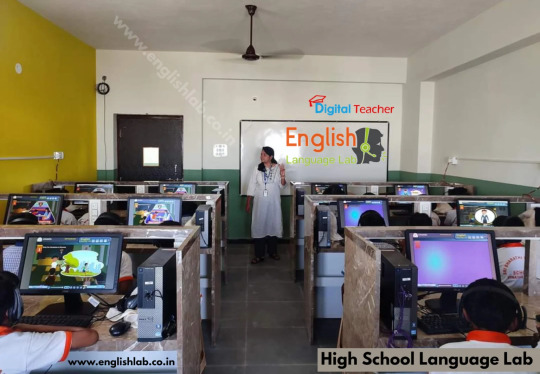
See how learners improve their speaking skills, teachers implement the software into their classes, and schools around the country celebrate achievement in the learning of a language.
Institute Review About: (English Language Lab Software)
Review: Ms Dima Amer, Operation Manager, Global Institute for Human Development, Syria
At the Global Institute for Human Development in Syria, sustainable education and global best practices are at the heart of their English qualification program. By incorporating Digital Teacher Software (English language laboratory), they provide a modern and engaging learning environment, meeting international standards like CEFR and MTI.
Our dedicated sales and technical teams have supported the partnership with Code and Pixels, which has played a key role in enhancing the educational experience for students and making the program a success.
Watch the video below to understand better “how our digital laboratory software?” is making a global impact!
youtube
Ms Dima Amer, Operation Manager, Global Institute for Human Development, Syria
English Medium High School Teachers’ Comments on Our (DT) Language Laboratory Software
Montessori’s English Medium High School:
Montessori’s English Medium High School is one of the institutions that uses our Digital Teacher Language Laboratory Software. It stands out for its important dedication to integrating digital labs and improving students’ English language skills.
The school’s management has made amazing strides to highlight these areas, recognizing their importance in students’ overall growth.
One special feature is our English language lab, which the school’s administration really likes. This excellent facility helps students learn languages and become good communicators, preparing them for opportunities around the world.
youtube
Montessori’s English Medium High School | English Language Lab Software
Another Success Storie of our English Laboratory Software!
As we continue to share success stories, Netaji Subhas University JunctionPur is another organization that is using our (DT) Digital Language Lab Software. A committed university English instructor describes how the lab has changed language instruction for students by making it interactive, interesting, and focused on objectives.
Students’ skills in communication have improved significantly at the institution as a result of including our lab software, increasing their self-assurance when speaking English. Students are now more equipped to achieve academic success and to better prepare for possibilities in the future.
See the impact of our school’s language lab software in reality and hear straight from the teacher in the video below!
youtube
Netaji Subhas University JunctionPur | English Language Lab Software
The above success stories from various locations demonstrate how the laboratory software levels the playing field, allowing everyone of any age, regardless of background, to achieve success.
Additionally, Feel free to look through our Client List at https://www.englishlab.co.in/clients to see more images and the most recent updates from schools and colleges that use our language laboratory software.
These real-life examples, from plenty of institutions all over the world, demonstrate the significant impact our software continues to make in classrooms everywhere.
English Language Lab Digital Teacher: (YouTube)
Visit our YouTube channel: ” English Language Lab Digital Teacher ” for more success stories, updates, and an in-depth look at how the Digital Teacher English Language Laboratory Software is changing teaching.
There, you can see additional videos of our clients in action and have a better idea of how our software helps students all around the world develop effective communication skills.
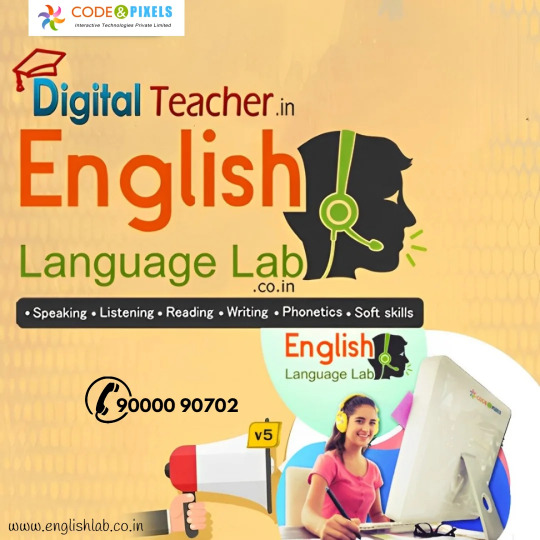
Contact us 📞 90000 90702 (or) Visit 🌐 https://www.englishlab.co.in/ today and start the language learning revolution!
#digital language laboratory#government school language lab#language laboratory software#school language labs#language lab India#digital language lab for students#digital language laboratory in educational institutes#English language learning in government schools#government school English language lab#best English language laboratory in India#Youtube
1 note
·
View note
Text
JAWAHAR NAVODAYA VIDYALAYA JNV SHOPIAN WALK-IN-INTERVIEW NOTIFICATION 2024
JAWAHAR NAVODAYA VIDYALAYA JNV SHOPIAN WALK-IN-INTERVIEW NOTIFICATION 2024. PM SHRI SCHOOL JAWAHAR NAVODAYA VIDYALAYA AGLAR DISTT. SHOPIAN (J&K-UT)- 192305 PM SHRI WALK-IN-INTERVIEW Jawahar Navodaya Vidyalaya Aglar, District Shopian (J&K) UT invites female candidates for walk in interview for the post of Matron on contract basis for the session 2024-25 Eligibility…
0 notes
Text
#PM SHRI Schools Scheme#Robotics kit for PM SHRI Schools#PM SHRI Schools#What is the PM-SHRI scheme#Psychometric Tests for PM SHRI School#Smart Class for PM SHRI School
1 note
·
View note
Text
PM discusses India's growth with top Tech-CEOs at MIT-sponsored roundtable in New York
Prime Minister Shri Narendra Modi interacted with technology industry leaders in New York in a Roundtable anchored by the Massachusetts Institute of Technology (MIT), School of Engineering. The tech-roundtable focused on Artificial Intelligence and Quantum; Biotechnology and Life Sciences; Computing, IT and Communication; and Semiconductor technologies. The CEOs participated in a deep dive with…
0 notes
Text



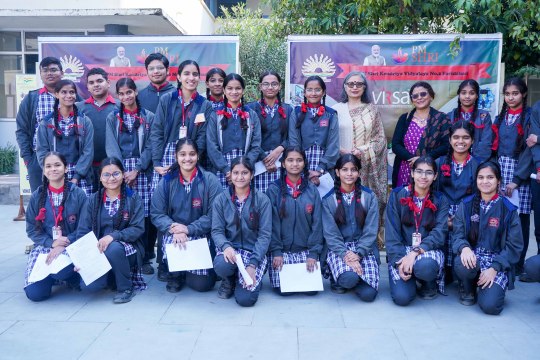
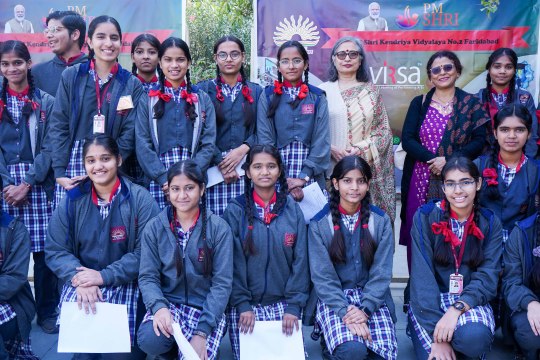
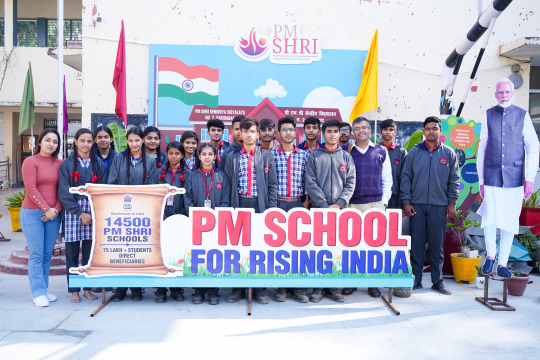
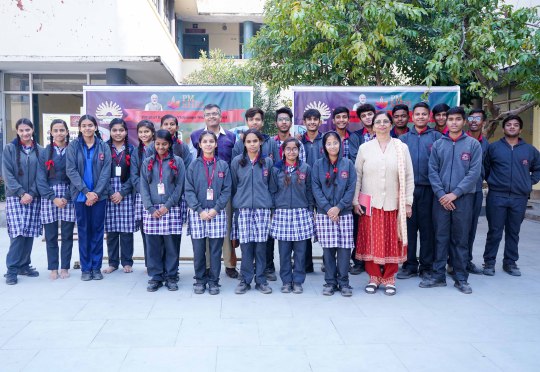
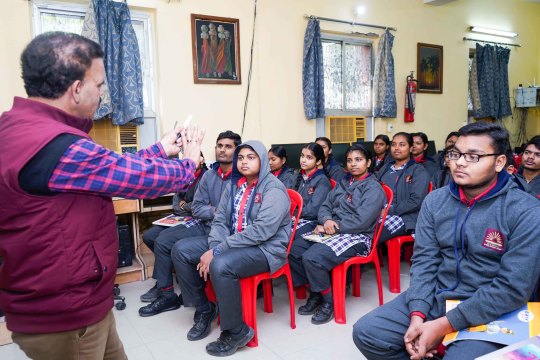
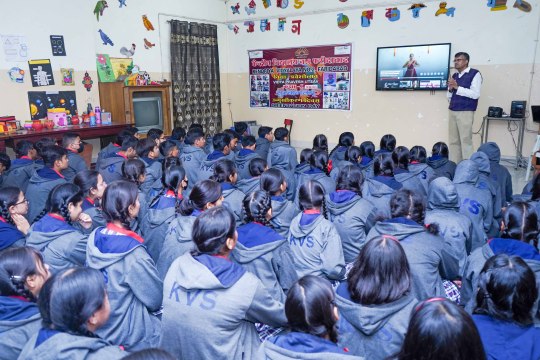
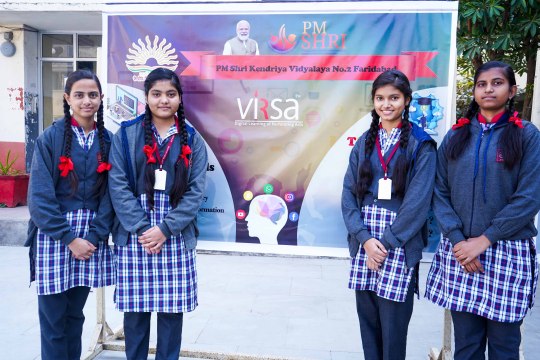
VIRSA is a registered start-up company which provides skill training that lasts for a lifetime and is gateway & platform to the world of performing arts.
VIRSA INDIA conducts various recurring & non-recurring activities under different pillars of PM SHRI Schools as per the vision of the National Education Policy.
0 notes
Text
கல்வி நிதியை நிறுத்திய மத்திய அரசு: தமிழக பள்ளிக் கல்வித்துறைக்கு ஏற்படும் பாதிப்புகள் என்னென்ன?! | PM SHRI: The bjp govt stopped the school education fund to tamil nadu: what's the problem?
0 notes
Text
[ad_1] Deutsche Bank and The Akshaya Patra Foundation have further strengthened their long-standing partnership to combat classroom hunger by initiating the construction of a state-of-the-art kitchen in Shivajinagar, Pune. The groundbreaking ceremony for this innovative facility marks a major milestone in their joint efforts to enhance the lives of underprivileged children through the Pradhan Mantri Poshan Shakti Nirman (PM POSHAN) scheme. The Akshaya Patra Foundation is the implementing partner of the PM POSHAN initiative and world’s largest NGO-Run school meal program. Ms Ruchi Khemka, Head CSR & Mr Kaushik Shaparia, CEO Deutsche Bank Group India; Sri Prithviraj BP, IAS; Shri Sampati Dasa, Regional President & Mr Shridhar Venkat, CEO, TAPF Expected to be operational by early 2026, the multi-level kitchen will provide over 25,000 daily hot, nutritious meals to students in government and government-aided schools across Pune. This initiative is aimed at improving school attendance, academic performance, and the overall health and well-being of marginalized children. The facility will adhere to the highest standards of hygiene and safety and is designed to serve as Akshaya Patra’s central kitchen in Pune. Beyond addressing nutrition and education, the project is poised to create employment opportunities and support local agriculture, fostering economic development within the community. The ceremony was attended by Mr. Kaushik Shaparia, CEO of Deutsche Bank Group, India, along with Shri Sampati Dasa, Regional President – Pune, The Akshaya Patra Foundation; Shri Shridhar Venkat, CEO, of The Akshaya Patra Foundation, Ms Ruchi Khemka, Head - CSR, Deutsche Bank Group, India, Praveen NR, IFS, Sri Prithviraj BP, IAS & other senior representatives from the Pune Government department & The Akshaya Patra Foundation and other dignitaries. Mr. Kaushik Shaparia, CEO of Deutsche Bank Group, India, highlighting the significance of this initiative, said, “At Deutsche Bank, we believe collaboration is vital to creating lasting social impact. This new kitchen in Pune reflects our unwavering commitment to addressing hunger and education, empowering students to realize their full potential. With our strong presence in Pune, we also look forward to engaging our employees in advancing this meaningful cause and fostering sustainable change.” Mr. Shridhar Venkat, CEO, from The Akshaya Patra Foundation, said, “Today's groundbreaking ceremony marks a significant milestone in our ongoing journey with Deutsche Bank to eradicate classroom hunger and foster educational opportunities for children across Pune. Through this state-of-the-art kitchen facility, we are set to enhance our operational capabilities significantly, thereby ensuring that over 25,000 students receive nutritious meals every school day. This initiative not only supports academic excellence but also strengthens the fabric of our communities by promoting better health and creating economic opportunities locally. We are immensely grateful to Deutsche Bank's for their support over the years. We also want to thank the Government of Maharashtra for providing us the opportunity to serve the children in the state. They have been instrumental in helping us make an impact and nurture the potential of every child we serve." Since 2014, Deutsche Bank has supported Akshaya Patra’s efforts to provide mid-day meals to students in Jaipur, Bengaluru, and Pune. Over the past decade, this partnership has facilitated the provision of over 8 crore meals to children, significantly enhancing educational opportunities for marginalized communities. In addition to the Pune kitchen, Deutsche Bank is extending its support to Akshaya Patra by funding meals for an additional 2,000 children in Gandhinagar, Ahmedabad. The Pune kitchen is set to play a critical role in scaling Akshaya Patra’s Mid-Day Meal Programme in Maharashtra, furthering its mission of eliminating hunger and ensuring access to education for all.
For more details, please log on www.db.com/india / www.akshayapatra.org. !function(f,b,e,v,n,t,s) if(f.fbq)return;n=f.fbq=function()n.callMethod? n.callMethod.apply(n,arguments):n.queue.push(arguments); if(!f._fbq)f._fbq=n;n.push=n;n.loaded=!0;n.version='2.0'; n.queue=[];t=b.createElement(e);t.async=!0; t.src=v;s=b.getElementsByTagName(e)[0]; s.parentNode.insertBefore(t,s)(window,document,'script', 'https://connect.facebook.net/en_US/fbevents.js'); fbq('init', '311356416665414'); fbq('track', 'PageView'); [ad_2] Source link
0 notes
Text
[ad_1] Deutsche Bank and The Akshaya Patra Foundation have further strengthened their long-standing partnership to combat classroom hunger by initiating the construction of a state-of-the-art kitchen in Shivajinagar, Pune. The groundbreaking ceremony for this innovative facility marks a major milestone in their joint efforts to enhance the lives of underprivileged children through the Pradhan Mantri Poshan Shakti Nirman (PM POSHAN) scheme. The Akshaya Patra Foundation is the implementing partner of the PM POSHAN initiative and world’s largest NGO-Run school meal program. Ms Ruchi Khemka, Head CSR & Mr Kaushik Shaparia, CEO Deutsche Bank Group India; Sri Prithviraj BP, IAS; Shri Sampati Dasa, Regional President & Mr Shridhar Venkat, CEO, TAPF Expected to be operational by early 2026, the multi-level kitchen will provide over 25,000 daily hot, nutritious meals to students in government and government-aided schools across Pune. This initiative is aimed at improving school attendance, academic performance, and the overall health and well-being of marginalized children. The facility will adhere to the highest standards of hygiene and safety and is designed to serve as Akshaya Patra’s central kitchen in Pune. Beyond addressing nutrition and education, the project is poised to create employment opportunities and support local agriculture, fostering economic development within the community. The ceremony was attended by Mr. Kaushik Shaparia, CEO of Deutsche Bank Group, India, along with Shri Sampati Dasa, Regional President – Pune, The Akshaya Patra Foundation; Shri Shridhar Venkat, CEO, of The Akshaya Patra Foundation, Ms Ruchi Khemka, Head - CSR, Deutsche Bank Group, India, Praveen NR, IFS, Sri Prithviraj BP, IAS & other senior representatives from the Pune Government department & The Akshaya Patra Foundation and other dignitaries. Mr. Kaushik Shaparia, CEO of Deutsche Bank Group, India, highlighting the significance of this initiative, said, “At Deutsche Bank, we believe collaboration is vital to creating lasting social impact. This new kitchen in Pune reflects our unwavering commitment to addressing hunger and education, empowering students to realize their full potential. With our strong presence in Pune, we also look forward to engaging our employees in advancing this meaningful cause and fostering sustainable change.” Mr. Shridhar Venkat, CEO, from The Akshaya Patra Foundation, said, “Today's groundbreaking ceremony marks a significant milestone in our ongoing journey with Deutsche Bank to eradicate classroom hunger and foster educational opportunities for children across Pune. Through this state-of-the-art kitchen facility, we are set to enhance our operational capabilities significantly, thereby ensuring that over 25,000 students receive nutritious meals every school day. This initiative not only supports academic excellence but also strengthens the fabric of our communities by promoting better health and creating economic opportunities locally. We are immensely grateful to Deutsche Bank's for their support over the years. We also want to thank the Government of Maharashtra for providing us the opportunity to serve the children in the state. They have been instrumental in helping us make an impact and nurture the potential of every child we serve." Since 2014, Deutsche Bank has supported Akshaya Patra’s efforts to provide mid-day meals to students in Jaipur, Bengaluru, and Pune. Over the past decade, this partnership has facilitated the provision of over 8 crore meals to children, significantly enhancing educational opportunities for marginalized communities. In addition to the Pune kitchen, Deutsche Bank is extending its support to Akshaya Patra by funding meals for an additional 2,000 children in Gandhinagar, Ahmedabad. The Pune kitchen is set to play a critical role in scaling Akshaya Patra’s Mid-Day Meal Programme in Maharashtra, furthering its mission of eliminating hunger and ensuring access to education for all.
For more details, please log on www.db.com/india / www.akshayapatra.org. !function(f,b,e,v,n,t,s) if(f.fbq)return;n=f.fbq=function()n.callMethod? n.callMethod.apply(n,arguments):n.queue.push(arguments); if(!f._fbq)f._fbq=n;n.push=n;n.loaded=!0;n.version='2.0'; n.queue=[];t=b.createElement(e);t.async=!0; t.src=v;s=b.getElementsByTagName(e)[0]; s.parentNode.insertBefore(t,s)(window,document,'script', 'https://connect.facebook.net/en_US/fbevents.js'); fbq('init', '311356416665414'); fbq('track', 'PageView'); [ad_2] Source link
0 notes
Text
Shri Venkateshwara University held a seminar on the importance of the Indian Constitution to celebrate National Constitution Day.


















On National Constitution Day, Shri Venkateshwara University/Institute held a one-day seminar on the importance of the Indian Constitution for the rights of a common man.
The Orators & Jurists asserted the Indian Constitution confers equal rights for all & this quality makes it the strongest constitution of the world.
The Venkateshwara Group Founder President Dr Sudhir Giri, Pro Chancellor Dr Rajeev Tyagi, Chief Advisor Dr VPS Arora & the VC Dr Krishna Kant Dave inaugurated the event by lighting a lamp to Goddess Saraswati.
The Medical Dean, Dr Atul Verma, along with Dr Madhu Chaturvedi, joined them to unveil the seminar on the importance of the Indian Constitution for the rights of the Common Man.
The Venkateshwara Group Founder President, Dr Sudhir Giri, reiterated the Indian Constitution is the most powerful and strongest of all because it provides certain fundamental rights to the common man as given to the Prime Minister of India.
A common man has the right to education, equality, freedom & to vote as conferred to the PM of the country.
India’s independence was not just about breaking free from the British empire. It also involved creating a robust constitution that granted fundamental rights and duties to every Indian.
This allowed India to become the most powerful democracy globally.
The Pro Chancellor Dr Rajeev Tyagi asserted because of the Right to Education, meritorious students from underprivileged families can avail free education from the best public schools in the country. Under RTE, they receive education free of the cost.
The right to education, equality, freedom, and privacy allows all people to live with dignity, just like those who are privileged.
The VC Dr Krishna Kant Dave asserted let’s come together to perform our duties towards the country along with our fundamental rights as guaranteed by the Constitution.
Dr Rajwardhan Singh from the School of Law, Shri Venkateshwara University, emphasized that because of the power of constitution, the common man vote is equivalent to that of the Prime Minister & the President of India.
Later, the Registrar Dr Piyush Pandey informed students about their constitutional rights, duties & the students pledged to follow them as per the constitution & protect it.
Dr Rajesh Singh, Dr Rajwardhan Singh from the Law department & Dr Madhu Chaturvedi also addressed the seminar on the occasion of National Constitution Day.
Those present included Dr TP Singh, Dr Divya Girdhar, Dr Ashutosh Singh, Dr Yogeshwar Singh, Dr Anil Jaiswal, Dr Shilpa Raina & Dr Seema Sharma.
The Meerut Campus Director, Dr Pratap Singh, was present along with the Media Incharge, Mr. Vishwas Rana, among others.
0 notes